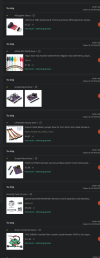- Joined
- Dec 25, 2023
- Messages
- 592
- Likes
- 623
I'm getting fed up with how there are absolutely zero (0) options in the market for a cheap and simple DSP device that can just apply whatever effect I want and be done with it. So, I'm starting development of the software base of what may in the future become a complete DSP system for audio, and also other things related to that.
Here are the gory details:
Here are the gory details:
- It will run on cheap and newly available RISC-V platforms like this one: https://milkv.io/duo-s
- The software will support any DSP effect in the special language derived from RISC-V assembly, not just the baby ones mandated for things like miniDSP nor the bespoke graphical ones for Sigma boards
- The software will be free and open-source and the hardware cheap, like really cheap (compared to the competition like miniDSP)
- The overall experience might be similar to HiFiBerry, but with less emphasis on music playback and more on raw DSP
- The first available hardware could be the Duo S board above just connected to a couple 3.5mm jacks using the built in ADC/DAC
- It currently only barely exists in a GitHub repo that I won't share right now, but is out there if you know what to search for
- Did I mention that it'll be cheap?
Last edited:
